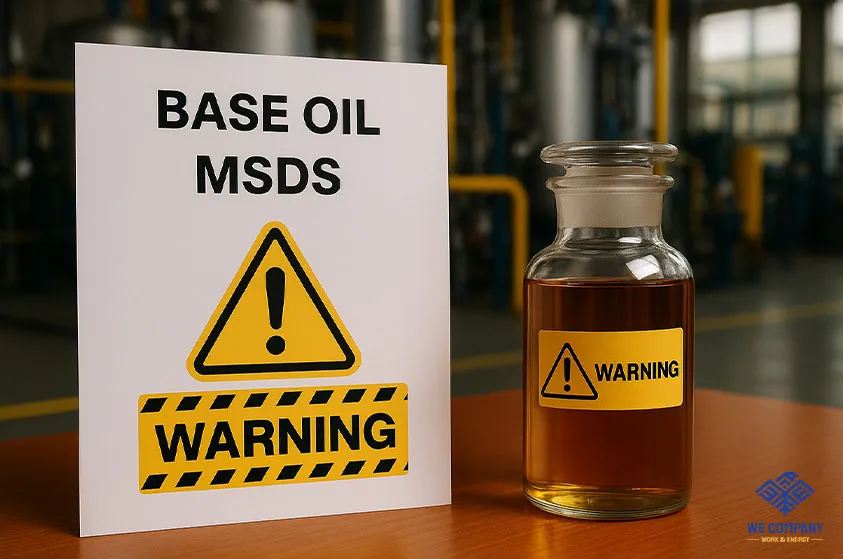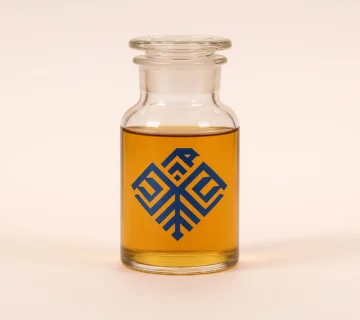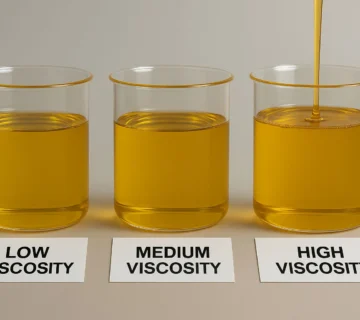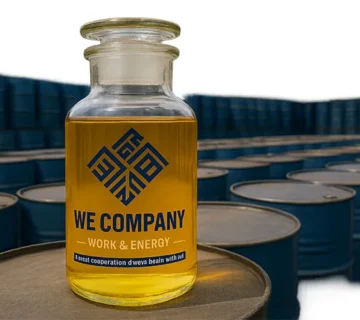Base Oil MSDS: Safety and Key Information
Base oil is a critical component in the production of lubricants, motor oils, and various other industrial products. Understanding the Material Safety Data Sheet (MSDS) for base oil is essential to ensure its safe handling, storage, and application. In this post, we will discuss the key elements of base oil MSDS and how to safely use, store, and dispose of it. As a leading supplier of base oil in the Middle East, Work and Energy Company (WE Co.) emphasizes the importance of safety and proper handling.
1. What is a Base Oil MSDS?
A Base Oil MSDS (Material Safety Data Sheet) provides detailed safety and technical information about base oil. It includes chemical composition, hazard identification, first aid measures, fire-fighting measures, and instructions for handling and storage. The MSDS is designed to inform workers, emergency responders, and consumers about the potential hazards associated with base oil and how to mitigate them.
2. Key Components of Base Oil MSDS
Identification: This includes the product name, its recommended uses, and any restrictions. Base oil is primarily used as a lubricant and process oil.
Hazard Identification: Base oil falls under GHS Classification with mild skin irritation (Category 3) and harmful if inhaled (Category 4). It is classified with a “Warning” signal and must be handled with caution.
First Aid Measures: In case of eye or skin contact, immediately flush with water for at least 15 minutes. If inhaled, remove the victim to fresh air.
Fire-Fighting Measures: Use dry chemical, carbon dioxide, or regular foam to extinguish fires. Avoid using water jets on spills or leaks.
Handling and Storage: Base oil should be stored in well-ventilated areas, away from heat sources, and in containers that are leak-proof.
3. Safety and Environmental Concerns
While base oil is stable under normal conditions, it poses risks such as mild skin irritation, respiratory concerns when inhaled in large quantities, and the potential to emit flammable vapors during a fire. It is important to follow safety protocols to minimize environmental impacts, including preventing spillage into waterways and using proper containment procedures.
Here is the extracted text from the PDF you uploaded, maintaining the formatting and content as is:
SAFETY DATA SHEET
BASE OIL MSDS PDF
- IDENTIFICATION
A. Product name
Base OilB. Recommended use and restriction on use- General use: Process Oil, Lube base oil
- Restriction on use: Observe the law and regulation.
- HAZARD IDENTIFICATION
A. GHS Classification- Acute Toxicity (Inhalation: dust/mist): Category 4
- Skin corrosion/irritation: Category 3
B. GHS label elements
- Hazard symbols
- Signal words: Warning
- Hazard statements
- H316 Cause mild skin irritation.
- H332 Harmful if inhaled
- Precautionary statements
- Prevention
- P261 Avoid breathing gas/mist/vapours/spray.
- P271 Use only outdoors or in a well-ventilated area.
- Response
- P304+P340 IF INHALED: Remove victim to fresh air and keep at rest in a position comfortable for breathing.
- P312 Call a POISON CENTER or doctor/physician if you feel unwell.
- P332+P313 If skin irritation occurs: Get medical advice/attention.
- Storage
- Not applicable
- Disposal
- Not applicable
- Prevention
C. Other hazards which do not result in classification:
- NFPA Classification
- Health: 1, Flammability: 1, Reactivity: 0
Chemical Name
- Distillates (petroleum), hydrotreated heavy paraffinic
CAS No. - 64742-54-7
Content(%) - 100%
- FIRST AID MEASURES
A. Eye contact- Do not rub your eyes.
- Immediately flush eyes with plenty of water for at least 15 minutes and call a doctor/physician.
B. Skin contact
- Flush skin with plenty of water for at least 15 minutes while removing contaminated clothing and shoes.
- Launder contaminated clothing before reuse.
C. Inhalation contact
- When exposed to large amounts of steam and mist, move to fresh air.
- Take specific treatment if needed.
- If breathing is stopped or irregular, give artificial respiration and supply oxygen.
D. Ingestion contact
- Take the advice of a doctor about whether to induce vomiting.
- Rinse your mouth with water immediately.
- FIREFIGHTING MEASURES
A. Suitable (Unsuitable) extinguishing media- Dry chemical, carbon dioxide, regular foam extinguishing agent, spray
- Avoid the use of water jet for extinguishing
B. Specific hazards arising from the chemical
- Not available
C. Special protective actions for firefighters
- Keep unauthorized personnel out.
- Withdraw immediately in case of rising sound from venting safety devices or discoloration of tank.
- Notify your local fire station and inform the location of the fire and characteristics hazard.
- Wear appropriate protective equipment.
- Keep containers cool with water spray.
- Vapor or gas is burned at distant ignition sources can spread quickly.
- ACCIDENTAL RELEASE MEASURES
A. Personal precautions, protective equipment and emergency procedures- Wear proper personal protective apparatus as indicated in Section 8 and avoid skin contact and inhalation.
- Ventilate closed spaces before entering.
- Move container to a safe area from the leak area.
- Handle damaged containers or spilled material after wearing protective equipment.
- Do not direct water at spill or source of leak.
B. Environmental precautions
- Prevent runoff and contact with waterways, drains, or sewers.
- If large amounts have been spilled, inform the relevant authorities.
C. Methods and materials for containment and cleaning up
- Large spill: Stay upwind and keep out of low areas. Dike for later disposal.
- Notification to central government, local government when emissions at least of the standard amount.
- Dispose of waste in accordance with local regulations.
- Appropriate container for disposal of spilled material collected.
- Small leak: Sand or other non-combustible material, please let use absorption.
- Wipe off the solvent.
- Dike for later disposal.
- HANDLING AND STORAGE
A. Precautions for safe handling- Wash thoroughly after handling.
- Deal only with a well-ventilated place.
- Do not handle until all safety precautions have been read and understood.
- Operators should wear antistatic footwear and clothing.
- Do not inhale the steam prolonged or repeatedly.
B. Conditions for safe storage, including any incompatibilities
- Check regularly for leaks.
- Do not apply direct heat.
- Follow applicable laws and regulations.
- Prevent static electricity and keep away from combustible materials or heat sources.
- EXPOSURE CONTROLS/PERSONAL PROTECTION
A. Exposure limits- [Distillates (petroleum), hydrotreated heavy paraffinic]: TWA 5 mg/m3, Inhalable particulate matter (Mineral oil, Pure, highly and severely refined)
B. Engineering controls
- A system of local and/or general exhaust is recommended to keep employee exposures above the Exposure Limits. Local exhaust ventilation is generally preferred because it can control the emissions of the contaminant at its source, preventing dispersion of it into the general work area. The use of local exhaust ventilation is recommended to control emissions near the source.
C. Individual protection measures, such as personal protective equipment
- Respiratory protection
- Under conditions of frequent use or heavy exposure, respiratory protection may be needed.
- Respiratory protection is ranked in order from minimum to maximum.
- Consider warning properties before use.
- Any chemical cartridge respirator with organic vapor cartridge(s).
- Any chemical cartridge respirator with a full facepiece and organic vapor cartridge(s).
- Any air-purifying respirator with a full facepiece and an organic vapor canister.
- Eye protection
- Wear primary eye protection such as splash-resistant safety goggles with secondary protection face shield.
- Provide an emergency eye wash station and quick drench shower in the immediate work area.
- Hand protection
- Wear appropriate gloves.
- Skin protection
- Wear appropriate clothing.
- PHYSICAL AND CHEMICAL PROPERTIES
A. Appearance- Liquid
- Color: Yellow
B. Odor
- Mild hydrocarbon odor
C. Odor threshold
- Not available
D. pH
- Not available
E. Melting point/Freezing point
- Not available
F. Initial Boiling Point/Boiling Ranges
280°C
G. Flash point
- ≥244°C
H. Evaporation rate
- Not available
I. Flammability(solid, gas)
- Not available
J. Upper/Lower Flammability or explosive limits
- 1-10%(v)
K. Vapor pressure
- <0.5Pa (20°C)
L. Solubility
- Not available
M. Vapor density
1.0 (air=1)
N. Specific gravity (Relative density)
- Not available
O. Partition coefficient of n-octanol/water
6
P. Autoignition temperature
320°C
Q. Decomposition temperature
- Not available
R. Viscosity
- Not available
S. Molecular weight
- Not available
- STABILITY AND REACTIVITY
A. Chemical Stability
- This material is stable under recommended storage and handling conditions.
B. Possibility of hazardous reactions
- Hazardous polymerization will not occur.
C. Conditions to avoid
- Avoid contact with incompatible materials and conditions.
- Avoid accumulation of electrostatic charges, heating, flames, and hot surfaces.
D. Incompatible materials
- Not available
E. Hazardous decomposition products
- May emit flammable vapor if involved in fire.
- TOXICOLOGICAL INFORMATION
A. Information on the likely routes of exposure
- (Respiratory tracts): Not available
- (Oral): Not available
- (Eye·Skin): Causes mild skin irritation.
B. Delayed and immediate effects and also chronic effects from short and long term exposure
- Acute toxicity
- Oral: [Distillates (petroleum), hydrotreated heavy paraffinic]: LD50 >15000 mg/kg (Rat)
- Dermal: [Distillates (petroleum), hydrotreated heavy paraffinic]: LD50 >5000 mg/kg (Rabbit)
- Inhalation: [Distillates (petroleum), hydrotreated heavy paraffinic]: Mist LC50 = 2.18 mg/L (4 hr Rat)
- Skin corrosion/irritation
- Causes mild skin irritation.
- ECOLOGICAL INFORMATION
A. Ecotoxicity
- Fish: [Distillates (petroleum), hydrotreated heavy paraffinic]: LC50 >5000 mg/L (96 hr Oncorhynchus mykiss)
- Crustaceans: [Distillates (petroleum), hydrotreated heavy paraffinic]: EC50 >1000 mg/L (48 hr Daphnia magna)
- Algae: [Distillates (petroleum), hydrotreated heavy paraffinic]: EC50 >1000 mg/L (96 hr Scenedesmus subspicat)
- DISPOSAL CONSIDERATIONS
A. Disposal methods
- Since more than two kinds of designated waste are mixed, it is difficult to treat separately, then can be reduced or stabilized by incineration or similar process.
- Dispose by incineration.
- TRANSPORT INFORMATION
A. UN No. (IMDG)
- Not available
- REGULATORY INFORMATION
A. National and/or international regulatory information
- POPs Management Law: Not applicable
- Information of EU Classification
- Classification: [Distillates (petroleum), hydrotreated heavy paraffinic]: Carc. Cat. 2; R45
- OTHER INFORMATION
A. Reference
- The information contained herein is believed to be accurate. It is provided independently of any sale of the product for the purpose of hazard communication.
Top 10 FAQs About Base Oil
1. What is base oil used for?
Base oil is mainly used in the production of lubricants and motor oils. It is also used in the formulation of industrial oils, greases, and hydraulic fluids.
2. Is base oil harmful?
Base oil can cause mild skin irritation and respiratory issues if inhaled in large amounts. It is important to follow safety guidelines for handling and storage.
3. How should base oil be stored?
Base oil should be stored in a cool, dry, and well-ventilated area away from heat sources or open flames. Containers should be leak-proof to avoid contamination.
4. Can I dispose of base oil with regular waste?
No, base oil should be disposed of according to local environmental regulations. It is recommended to use a waste management company that specializes in chemical waste disposal.
5. What are the fire risks associated with base oil?
Base oil is flammable and can emit flammable vapors if involved in a fire. Use dry chemical, CO2, or foam extinguishing agents and avoid water jets.
6. What are the main ingredients in base oil?
Base oil typically consists of hydrotreated heavy paraffinic distillates, which are highly refined petroleum oils.
7. How do I handle base oil spills?
In case of a spill, prevent the oil from entering water sources, and contain it using non-combustible materials like sand. Dispose of waste according to local regulations.
8. What safety gear should be used when handling base oil?
Wear appropriate protective equipment, including gloves, goggles, and a respirator if necessary. Ensure proper ventilation in the workspace.
9. How does base oil impact the environment?
Base oil is biodegradable to a limited extent but can accumulate in the environment if not disposed of properly. It is crucial to follow ecological disposal methods to minimize its impact.
10. What is the shelf life of base oil?
Base oil has a long shelf life if stored properly, away from direct heat and in sealed containers to prevent contamination.
Why Choose Work and Energy Company (WE Co.) for Base Oil in the Middle East?
As one of the leading suppliers of base oil in the Middle East, Work and Energy Company (WE Co.) ensures the highest quality and safety standards for all our products. Whether you need base oil for automotive, industrial, or manufacturing applications, we offer a range of products tailored to your needs. We are committed to offering timely and safe deliveries, ensuring your supply chain runs smoothly.
For more information or to place an order, visit our Base Oil Archive Page and contact us via WhatsApp at +989101717647. Let us be your trusted partner for premium base oil products in the Middle East.
WhatsApp: (+971) 585992028
Phone: (+971) 58 599 20 28
Email: info@workandenergy.com
Office Address: No. 106, Sabkha Tower, Deira, Dubai, UAE






No comment